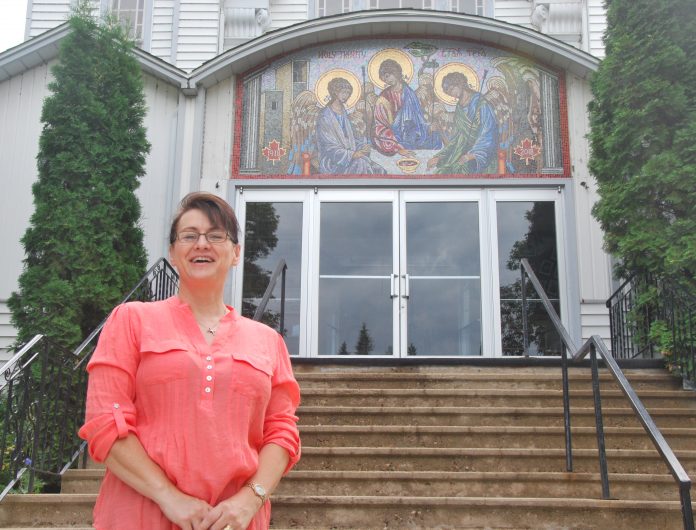
Local artist creates mosaic to commemorate 100 years of the Ukrainian Orthodox Church in Canada
Prince Albert’s Holy Trinity Ukrainian Orthodox Church is recognizing the upcoming centennial of the Church’s arrival in the province with the unveiling of a new mosaic.
Holy Trinity approached local painter and church member Karen Isbister to create an icon on the outside of the church above the main entrance. The work took four months to create and it was installed this week. The final product is 12 feet wide, nearly six feet high and contains between 60,000 and 70,000 individual glass pieces.
“Because I’ve done lots of icons for the church in the inside, they discussed that it would be nice to be able to bring some of the beauty of the church that’s inside to the outside for people that walk by,” she explained.
Isbister has painted around 20 icons for the church since the building underwent renovations in 2010. Icons are symbolism-rich religious images made in a traditional, Byzantine art style that depict saints and scenes from scripture.
Isbister decided the appropriate icon for the project would be a rendition of The Trinity, a famous work by 15th century Russian painter Andrei Rublev. The icon portrays the Father, Son and Holy Ghost as they visited Abraham in the Book of Genesis. Because paint would not fare well against the elements, Isbister decided to make a glass mosaic, instead.
The only problem was she had never made a mosaic before. Isbister described the process as “winging it,” but she said growing up in a First Nations household helped prepare her for the project.
“We all had to learn how to bead so we did beadwork on leather,” she said.
“So I figured the concept is kind of similar, it’s making an image with pieces of glass, so I said, ‘You know what? Yeah, I can do this.”
Isbister designed the mosaic in her garage with the help of her husband, Wes, who built a work table specifically for the project. Isbister ordered the special coloured glass, which she said is “considered the Cadillac of mosaic material” from a supplier in Toronto. The glass arrived in half-inch cubes, which were then individually cut into pieces as small as one eighth of an inch wide to fit the mosiac.
The first piece of glass was placed on April 1 and the final touches were made on July 28. Isbister worked on the more detailed sections, while Wes completed much of the icon’s background. Isbister said the project would have taken twice as long without Wes’ help. She said she spent more than 40 hours alone on each of the angel’s faces.
Isbister said she finds creating icons to be more meaningful and involving than “slapping on headphones” and painting portraits or wildlife.
“It’s really fun. You’re creating something, it’s beautiful, it’s nice to look at but when I do (icons), I study what I’m doing first,” she said.
“I do my research and I study what each symbol means, why I’m doing it this way, the colours, the story behind it… You’re not just painting a pretty picture, you’re writing the story.”
For more on this story, please read the Prince Albert Daily Herald¹s subscription-based print or e-editions.

